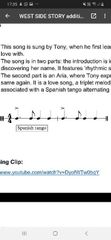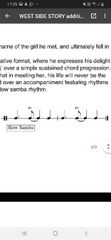![]()
![]()
![]()
Use LEFT and RIGHT arrow keys to navigate between flashcards;
Use UP and DOWN arrow keys to flip the card;
H to show hint;
A reads text to speech;
44 Cards in this Set
- Front
- Back
|
What do all the elements and parts of a musical create? |
An atmosphere and they reinforce the plot of the story. |
|
|
What is a revue? |
A production with scenes that aren’t threaded together with a storyline. |
|
|
3 types of music in musical productions |
- solos, ensembles & chorus ~s & e’s are sung by characters as part of the dialogue of the play (vocal duets / trios) ~choruses are written for the whole cast and reinforce climax of plot in production - ‘recitative’ or Sprechstimme ~orchestra or instrumental music serves as accompaniment to a speech-like dialogue that’s sung or just spoken by one or more characters. - incidental music ~without any voices or dialogue. ~reinforces atmosphere and sets the tone for the drama unfolding ( or about to ) ~can contain themes of characters on stage or be part of the plot. ~aids the flow in transition between scenes or acts |
|
|
Who composed the music for My Fair Lady? |
Frederick Loewe - Austrian born (1901-1988) |
|
|
Who was the librettist for My Fair Lady? |
Alan Jay Lerner - American born (1918-1986) - wrote lyrics |
|
|
Comment on Lerner and Loewe’s relationship and what marks the beginning of their partnership. |
The two met in New York in 1942 and collaborated in writing musicals until Lerner’s death. The first musical (marks beginning) is Life of the Party (1942). Other works ( What’s up, The Day before Spring, Brigadoon, Paint your Wagon, My Fair Lady, Camelot and Gigi) followed. |
|
|
What is My Fair Lady?My |
A musical based on a play written by George Bernard Shaw in 1912 called Pygmalion. |
|
|
My Fair Lady’s premiers. |
- musical version first performers in New York (1956) - two years later (1958) in London - first film premiered 1964 |
|
|
Synopsis of My Fair Lady |
A Cockney flower seller Miss Eliza Doolittle (Audrey Hepburn) is taken as a student by a professor of phonetics, Henry Higgins (Rex Harrison). Eliza is having speech lessons from him so that he can present her as a ‘proper lady’. The entire play is in two Acts, 18 scenes. |
|
|
Libretto of My Fair LadyHow |
It is unique because it includes the heavy ‘Cockney accent’ in the lyrics of the songs. Especially in Wouldn’t it be Loverly and With a little bit of Luck. |
|
|
How does the librettist reinforce the reality of the plot?The |
As a part of the phonetic training, some of the lyrics are sung in a heavy Cockney accent and others in ‘proper English’ while some songs contain both. |
|
|
The orchestration of My Fair Lady |
Music is written for a standard Western Symphonic Orchestra (Violin 1 & 2, Viola, Violoncello, Double Bass, Woodwinds, Trumpets, Trombones, French Horns, Percussion and Piano Celesta. Reflects Loewe’s formal music training in very Romantic -Dramatic orchestration, with the exception of some light hearted Cockney dance pieces and Gavottes. |
|
|
Gavotte |
An old French dance in common time beginning on the 3rd beat. Later becoming one of the movements of that standard Baroque suite. |
|
|
The Rain in Spain |
Sung by Eliza, Prof Higgins and Colonel Pickering. - lyrics contain some strange pronounced words in a heavy Cockney accent, then improving during the song as she learns new phonetics . - the lyrics are ‘non-sensical’ and tell no story at all. Its a reiteration of the lines and phrases Prof uses to improve Eliza’s dictation and articulation - orchestration is rich in ‘Spanish-isms’. Genre is derived from Spanish/Cuban folk dance, called Habanera - ornamentation in the form of triplets (occurs in orchestral accompaniment) - castanets and tambourines are percussion instruments featured in orchestration to enhance the Spanish feel of the music |
|
|
Habanera |
A slow Cuban song and dance which became very popular in Spain. The dance is written in simple duple time. |
|
|
Other songs |
On the street where you live, A little luck, I could’ve danced all night, I’ve grown accustomed to her face. |
|
|
Wouldn’t it be Loverly |
Eliza Doolittle expresses her dream of raising her quality of life. Its sung by Eliza, men quartet and full chorus. - huge instrumental section, featuring choreographed dance, is sandwiched between the verse and chorus. - title of the song purposely using ‘English slang’ which is frowned upon by character professor Higgins. (reinforces the period in which the musical is set, in particular the low class of people.) - many lyrics are derived from the Cockney accent (loverly, windersill, wouldn’t, absolbloomin-lutely, restin’) - classical Gavotte form but does not start on the 3rd beat as it does in its standard structure |
|
|
West Side Story music composer |
Leonard Bernstein |
|
|
West Side Story Librettist and Screenplay |
Stephen Joshua Sondheim |
|
|
West Side Story Synopsis |
- set in the 'slums' of the urban New York City - centering around a rivalry between two gangs (The Sharks and the Jets). - this rivalry dooms the love of Maria who is tied to the teenage street gang of the American/Puerto Ricans (Sharks) and Tony who is part of the native born American gang (Jets) - it's a modern portrayal of Shakespeare's Romeo and Juliet. - tension heightens when Maria's brother Bernando is killed in a gang fight and dies in her arms |
|
|
How is the drama and tension echoed in West Side Story |
in somewhat 'violent' original choreography by Jerome Robbins and Peter Gennaro. |
|
|
The libretto/lyrics of West Side Story |
- mainly in English but includes some phrases and greetings in Spanish (reinforces reality of two gangs Jets - American and Sharks - Puerto Rican in New York City) - songs sung in English by Sharks have lyrics with a very heavy latino accent - most screenplay is done in the same way or a combined version of both accents (duets sung by Maria & Tony) |
|
|
Orchestration of West Side Story |
- orchestrated for a very large orchestra (full strings, woodwinds (including Altos, Tenor and Baritone Saxophones, Piccolo, Eb and Bass clarinets), horns, 3 trumpets, 2 trombones, percussion, piano celeste and guitar. - contemporary 'Classical meets Jazz' with Jazz idiom containing lots of swing, Heavy Blues Rock and Standard Jazz Styles but the originality in the score is due to the inclusion of Spanish-isms - Riffs, licks and melodies that are latino in origin, including original latino dance types (Paso doble, salsa rhythms, bossa nova and samba) - dances and latino rhythms are weaved into the songs and incidental music to once again reinforce the reality of the 2 opposing gangs |
|
|
Maria (WSS) |
- song is sung by Tony once he first learns the name of the girl he met and ultimately fell in love with - song is in 2 parts: introduction in recitative format (expresses delight in discussing discovering her name). features 'rhythmic speaking' over simple sustained chord progression - 2nd part is an Aria. (T expresses that after meeting her his life will never be the same) It's a love song, a triplet melody placed over an accompaniment featuring rhythms associated with Spanish tango alternating with slow samba rhythms |
|
|
Spanish tango |

|
|
|
Slow samba |

|
|
|
Tonight (WSS) |
- song number 10 - quintet sung by Tony, Maria, Anita, Riff and Bernado backed up by the Jets and Sharks - about everyone anticipating the events that are about to happen that night - 'quasi-operatic ensemble' style over a rhythmic accompaniment - 'moderate beguine tempo' is the tempo indication - Bernstein uses the drive of the beguine rhythm to express anxiety and the anticipation, thus setting the mood of the song |
|
|
3 trains of thought in Tonight |
- Riff and Bernado: thinking (in terms of their own gangs) of the fight arranged for later that evening - Anita: thinking about her 'nocturnal activities' with Barnado after the fight - Tony and Maria: more romantic love, idealised, though Tony has to agree with Riff, in exasperation, to be present at the fight |
|
|
Message of my Fair Lady |
probes important questions about social class, human behaviour, and relations between the sexes. not merely entertaining, considers social issues too |
|
|
year first performance |
1956 on Broadway |
|
|
WSS book |
Arthur Laurents |
|
|
WSS Choreographer |
Jerome Robbins |
|
|
First performance |
1957 on Broadway |
|
|
Habanera |
A slow Cuban song and dance which became very popular in Spain. The dance is written in simple duple time. |
|
|
Other songs |
On the street where you live, A little luck, I could’ve danced all night, I’ve grown accustomed to her face. |
|
|
Opera |
Dramatic work in which the whole/greater part of the text is sung with instrumental accompaniment |
|
|
Opera buffa |
Comic opera, began as use of comic subject involving characters drawn from every day life |
|
|
Opera seria |
Concept of the opera is serious, is is very formal and complex with elaborate display arias |
|
|
Operetta b |
A little opera, synonymous with “light opera” |
|
|
Burlesque |
Humorous form of entertainment involving element of satire and over exaggerated costumes |
|
|
Vaudevillepanyomine |
Variety show for entertainment |
|
|
Pantomime |
A play in which artists use dumb show and forms of satire |
|
|
Ballad opera |
Opera with spoken dialogue and using popular tunes of the day provided with new words |
|
|
Beguine |
broad term referring to the traditional music of a large part of the West Indies including Cuba, Jamaica, Hispaniola and Puerto Rico. characterised by almost universal use of clarinet and trombone |

